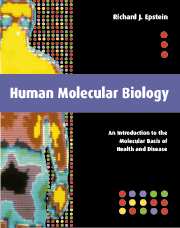Book contents
- Frontmatter
- Contents
- Preface
- Acknowledgements
- Read me first …
- Glossary
- Dedication
- Introduction: A disease for every gene?
- I From molecular biology to human genetics
- 1 Biomolecular evolution
- 2 Chromatin and chromosomes
- 3 Gene expression
- 4 RNA processing and translation
- 5 Protein structure and function
- II From molecular genetics to human biochemistry
- III From molecular biochemistry to human cell biology
- IV From molecular cell biology to human physiology
- V From molecular physiology to human molecular biology
- Index
4 - RNA processing and translation
Published online by Cambridge University Press: 01 June 2011
- Frontmatter
- Contents
- Preface
- Acknowledgements
- Read me first …
- Glossary
- Dedication
- Introduction: A disease for every gene?
- I From molecular biology to human genetics
- 1 Biomolecular evolution
- 2 Chromatin and chromosomes
- 3 Gene expression
- 4 RNA processing and translation
- 5 Protein structure and function
- II From molecular genetics to human biochemistry
- III From molecular biochemistry to human cell biology
- IV From molecular cell biology to human physiology
- V From molecular physiology to human molecular biology
- Index
Summary
RNA function
RNA has different forms and functions
The three-dimensional structure of single-stranded RNA differs from that of a linear polypeptide strip. First, RNAs contain only four inward-facing side-chains, whereas proteins contain 20 outward-facing side-chains. Second, RNA packs loosely and with low cooperativity, unlike the tight binding seen in proteins; this makes it more difficult for RNAs to specify a unique shape. Third, the structural stability of RNA is high, unlike that of most proteins. For example, long GC-rich sequences that are folded back upon themselves may have dissociation half-times of years, unlike a protein α-helix which dissociates within microseconds.
In contrast, the higher structures of RNA and DNA exhibit strong similarities. The formation of double-stranded regions occurs in short nucleic acid sequences termed inverted repeats or palindromes, the nucleotides of which snap back upon themselves to form in vitro structures called cruciforms in DNA and hairpins in RNA (Figure 4.2). Formation of these hairpins affects the transit of the transcription machinery along the elongating mRNA; hence, transcription may be punctuated by pauses involving additional protein–RNA and RNA–DNA interactions. The stem-loop hairpin is the principal secondary structure of RNA, with such structures providing targets for regulatory protein interactions in defined systems such as the HIV virus. The initial formation of RNA secondary structures can occur within 10−5 seconds, but the search for a stable folded tertiary structure may take seconds, or even minutes.
- Type
- Chapter
- Information
- Human Molecular BiologyAn Introduction to the Molecular Basis of Health and Disease, pp. 96 - 113Publisher: Cambridge University PressPrint publication year: 2002



